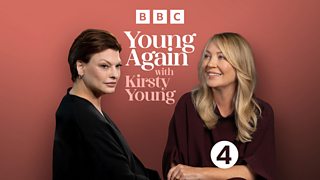Grayson Perry: Seven things we learned when he spoke to Kirsty Young
In her �鶹�� Radio 4 podcast, Young Again, journalist and broadcaster Kirsty Young takes her guests back to meet their younger selves and asks the question: if you knew then what you know now, what would you have done differently?
Grayson Perry is an artist and broadcaster best-known for his ceramics, tapestries and public appearances cross-dressing as his alter ego, Claire. His work draws on his childhood as well as wider contemporary events. During the pandemic he presented the TV series Grayson’s Art Club in which he encouraged the public to create and share their own artworks. He won the Turner Prize in 2003.
Here are the things we learned when he met Kirsty Young...

1. Grayson was knighted in the King’s New Year’s Honours in 2023. So how does he feel about joining the establishment?
Early on in their meeting Kirsty asks Grayson about how he sees the course his life has taken, saying: “You have in the past described your life as a fairy tale... I'm wondering now, as Sir Grayson, is this the happy ending of the fairy tale? Do you feel like it's complete?”
I've been pretty good at taking the temperature of society and looking at where the hot topics are: class and gender and masculinity and nationhood and the culture wars.
And Grayson replies, “Yes, I'm both Prince and Princess in this tale,” and they both burst out laughing. “I mean, it just keeps going on. I seem to climb the greasy pole of the establishment with fair ease.”
“And you embrace that establishment character now?” asks Kirsty.
“There's nothing worse than a sort of tired old creative person who still thinks they're a rebel, in their 60s. I think it's awful, you know: ‘Oh, yeah. I've always been against the establishment. Mate, you're Sir Grayson Perry!’ Plus, you can have a lot of fun from the inside, you know.”
2. The idea of social discomfort as a place of conflict is something that inspires Grayson’s thinking.
“I've been pretty good at, and fairly prescient often, in kind of taking the temperature of society and looking at where the hot topics are: class and gender and masculinity and nationhood and the culture wars,” explains Grayson.
“I look for the sore wound... You know, I've been on most of these things fairly quickly.'’
“I'm a kind of amateur sociologist, really social scientist, and so I'm taking readings of the patterns of society and where the heat is and the discomfort, and I think that's an interesting place to be.”

3. He cites two surprising influences on his work that are not always associated with each other.
"You know, there're two forces in my life – in my creative life,” says Grayson, “which are punk and The Hobbit.”
There're two forces in my life – in my creative life: punk and The Hobbit.Perry on the things that have shaped his art.
“Punk was well in in the foreground at that time – punk was the guy that is a wind-up merchant out for a laugh, politicised, very much trying to plug into the culture.
“The Hobbit is the craft and the kind of poetry and tradition and all those things.”
It’s a very apt description of Grayson's work, such as the ceramics and tapestries, in that they bring together topical subjects from the media with long-standing craft traditions.
4. Grayson started seeing a psychotherapist in his late 30s.
“I had a terrible temper. I could fly off the handle. I was a really bad road rager, because I would be on my motorbike and if someone cut me up, I would fly off the handle,” says Grayson.
“I had a very volatile temper, you know, no surprises there, considering.”
Grayson is referring to his childhood, part of which he spent with his mother and stepfather after his parents divorced and the rest of the time with his father. Earlier in the conversation he told Kirsty: “My mother was a volatile presence. In that her anger was the default emotion in our home. It was a lot of shouting, volcanic arguments and throwing of furniture...”
“My wife was training to be a therapist at the time,” says Grayson picking up the story, “and so she was in contact with a lot of other therapists. And I think anybody that's in contact with therapists becomes a little bit evangelical about it. And she just said one day, ‘I think I've met your therapist, right?’ You know she was looking for the right person and she gave me his number, and he was the right person. And it was great. It was a long six years, and it was one of the most profound things I've ever done.”
Kirsty asks him if he can share any of what it was like.
“It was like going to the movies where you were the hero every week and it was usually a weepy,” replies Grayson with a smile.
“My tap suddenly opened up from session one.”
“I always describe therapy as cleaning out the tool shed - a lot of people are scared of it because they think that it's going to change you. No, your fundamental self will stay the same but all the rubbish would be cleared out and the tools will still be there, and you might get some new tools. I found it very inspiring and at the same time it made me aware of the distortions in the lens I view the world [through]. And so therefore I had a clearer vision of the world and it really helped my work, and it gave me a subject as well.”
5. He has a very strict social media policy to maintain balance.
“Now we live in an age of disinformation and conspiracy theories, you know – you've got to be wary all the time,” Grayson tells Kirsty.
“For instance, on social media, I'm quite diligent about following lots of different people who I disagree with and hate, as well as people I like and agree with ’cos social media is really distorting. It's a perfectly-designed technology to inveigle its way into our unconscious, and so therefore it's affecting how we feel and think all the time.”
6. He describes himself as a "Christian atheist".
“I'm a Christian atheist. I'm steeped in the narratives and culture and art of Christianity – being a European – [but] I don't feel the belief emotionally,” says Grayson. “I think one of the powers of religion is you grow up with it. And so therefore it soaks into your unconscious and your body and the rhythms and your family and your society. And so therefore that's its potency.”
“You'd make a good Bishop,” says Kirsty, “I can see you in the rig-out is all I'm saying, now that you're part of the establishment.” And they both start laughing.
7. Grayson calls the effect of fame the Picasso-Napkin Syndrome.
Kirsty asks Grayson how great success as an artist has changed things. Grayson says he didn’t really become famous until his forties, by which time he’d mostly figured out the things he’s interested in.
“I think I'm more self-conscious now because I have what I call Picasso-Napkin Syndrome which is that kind of awareness of the value and attention that that my work will accrue,” says Grayson referring to the idea that anything by Picasso, even a drawing on a napkin done in a few seconds would be worth a fortune, because it was by the artist.
"So even drawing on a, you know, a little postcard... and I do it quite often for charities. They do these postcard sales, and it'll be a few grand, and it would take me not very long. And so that's great, I love that superpower.”
"I don't abuse it, but it means that I have a kind of idea of an audience in my head the whole time about everything I'm doing, so it makes me more self-conscious.”
“I think one of the great challenges to any creative person as they become successful and famous is to keep their unselfconscious joy in being creative."






